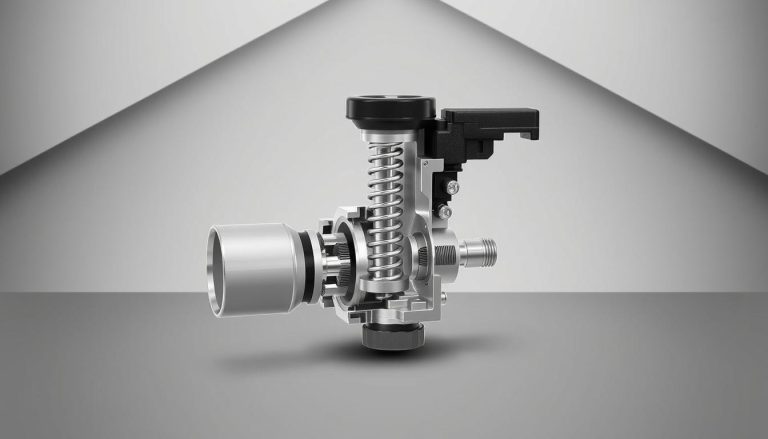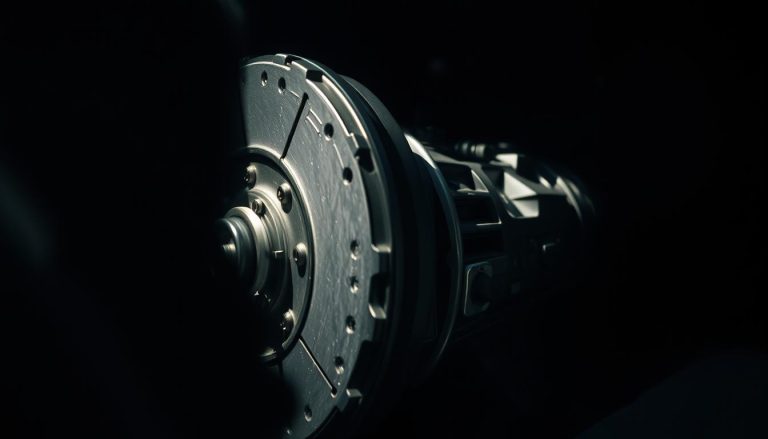Toyota Delayed Engagement: Causes & Solutions
Toyota cars are known for being dependable. But, some owners face a problem where the transmission takes time to engage. This is most noticeable when shifting from Reverse to Drive. Knowing why this happens can help find ways to fix it.
This article will explore the main reasons for Toyota delayed engagement. It will also look at which models are affected. Plus, it will discuss both quick fixes and long-term solutions for these transmission issues.
Understanding Delayed Engagement in Toyota Vehicles
In recent years, Toyota owners have had to deal with delayed engagement issues. This problem is linked to transmission problems. It’s when there’s a delay in shifting gears.
In Toyota cars, this delay is often seen when shifting from Reverse to Drive. It’s a noticeable problem.
What is Delayed Engagement?
Delayed engagement is when there’s a pause before the car shifts gears. It’s a hesitation followed by a sudden, uncomfortable jerk. This issue is common in many Toyota models.
It can be caused by low transmission fluid or wear and tear.
Common Symptoms of Delayed Engagement
Toyota drivers often notice a few symptoms. These include:
- Higher RPMs needed to engage drive mode
- Noticeable jerks when the gear engages
- Occasional clunking noises from the transmission
These issues are more common in cold weather. They may get better as the car warms up. So, it’s important to watch for these signs to keep your car running well.
Common Causes of Toyota Delayed Engagement
When your Toyota’s gears don’t engage right away, there are a few things to check. Knowing what causes this problem can help fix it. This makes your car run better and last longer.
Low Transmission Fluid
One common reason is low transmission fluid. Not enough fluid can make shifting gears slow. Always check and keep the fluid at the right level.
Mechanical Wear and Tear
As your car gets older, parts wear out. This can slow down gear shifting. Checking and fixing these parts is key to solving the problem.
Faulty Sensors
Bad sensors can send wrong signals to the car’s computer. This can cause shifting problems. Make sure all sensors are working right when you’re fixing your car.
Software Issues
Software problems can also slow down your car. If the software doesn’t control gear shifts well, it can cause delays. Updating the software is often a good fix.
Methods for Diagnosing Transmission Issues
Diagnosing transmission problems in your Toyota is key to keeping your car running well. There are several ways to find out why your transmission might be slow or have other issues. Let’s explore some top methods used by transmission mechanics for accurate diagnosis.
Checking Transmission Fluid Levels
Checking the transmission fluid levels is a first step in finding transmission problems. Low fluid can make shifting gears slow because it lowers hydraulic pressure. Also, looking for signs of contamination in the fluid, like a burnt smell or dark color, can show internal issues.
Diagnostic Scans
Advanced diagnostic scan tools are key for finding electronic problems in the transmission. These scans show fault codes for sensors, the transmission control module, and other parts. By understanding these codes, mechanics can quickly find and fix problems, saving time and money.
Mechanical Inspections
Mechanical inspections are important for spotting wear and tear on transmission parts. This includes checking the clutch, gears, and other parts inside. Finding physical damage or worn-out parts helps in planning the right repairs and keeping the transmission working long-term.
Toyota Models Affected by Delayed Engagement
Delayed engagement is a big problem for many Toyota models. It makes shifting gears hard and slow. This is a big issue for car owners.
2016 Toyota Tacoma
The 2016 Toyota Tacoma has had a lot of problems with its transmission. Owners often report delays when shifting gears. This can be really frustrating and needs to be watched closely.
Other Affected Models
Other Toyotas like the Corolla, Camry, and RAV4 also have these issues. While not as common as the Tacoma’s, it’s important for owners to keep an eye on their cars. Quick fixes can stop bigger problems from happening.
How to Check Transmission Fluid in a Toyota
Regularly checking your Toyota’s transmission fluid is key to keeping your car running smoothly. Start by finding the transmission fluid dipstick. It’s usually at the back of the engine bay. Here’s how to check the fluid:
- Make sure your Toyota is parked on a level surface and the engine is warm.
- Take out the dipstick, clean it with a rag, and put it back in fully.
- Take the dipstick out again to see the fluid level. It should be between “Full” and “Low”.
- Look at the fluid’s color and smell. It should be bright red and not smell burnt or gritty.
Checking the Toyota transmission fluid is not just about the level. It’s also about the quality. Bad or dirty fluid can cause problems. Keeping the fluid at the right level and quality is vital for your car’s maintenance.
Steps to Reset Toyota Transmission Control Module
Resetting the Toyota Transmission Control Module (TCM) can fix software issues with shifting. It’s easy to do and keeps your car’s transmission working right.
Disconnecting the Car Battery
First, turn off the car and find the battery. Use a wrench to remove the negative terminal cable. Let the car sit for 10 minutes to reset the computer.
Reconnecting the Battery
After 10 minutes, reconnect the negative terminal cable. Make sure it’s tight and secure. This starts the car’s systems rebooting, including the TCM.
Software Updates
After reconnecting the battery, check for software updates. Go to an authorized Toyota service center or the Toyota website. Updates can fix TCM problems and improve your car’s performance.
Preventative Maintenance for Toyota Transmissions
Keeping your Toyota’s transmission system running well is all about being proactive. Regular checks, fluid changes, and using genuine parts help a lot. This way, you can avoid problems like delayed engagement.
Regular Fluid Changes
Changing the transmission fluid regularly is key to preventive care. Fresh fluid keeps the parts moving smoothly, reducing damage. Always check your owner’s manual for when to change it.
Routine Inspections
Getting your car checked by certified techs is important. They can spot small problems early. This includes checking for wear, leaks, and other issues that could get worse if ignored.
Using Genuine Toyota Parts
When you need to replace or fix parts, use genuine Toyota ones. They fit perfectly and work right. Using other parts might cause problems because they don’t match Toyota’s standards.
DIY Solutions for Minor Transmission Issues
Keeping your Toyota’s transmission in good shape is key for a smooth ride. For small problems, there are easy DIY fixes. These are great if you know some Toyota maintenance tips.
Fluid Top-Up
One simple fix is to top up the transmission fluid. First, check the fluid level with the dipstick. If it’s low, add the right type of fluid slowly. Make sure it matches your Toyota’s needs.
Keeping the fluid level up helps fix small issues. It also stops bigger problems from happening.
Inspecting the Fluid Condition
Another DIY trick is to check the fluid’s condition. Good fluid is bright red and smells sweet. If it’s dark, dirty, or smells burnt, it’s time for a change.
Changing old or dirty fluid can really boost your car’s performance. It’s a simple task that makes a big difference.
| DIY Solution | Steps | Benefits |
|---|---|---|
| Fluid Top-Up |
|
|
| Inspecting Fluid Condition |
|
|
When to Seek Professional Help for Transmission Problems
Dealing with transmission issues in your Toyota can be tricky. Knowing when to get help from experts is key. It saves time, money, and keeps your car running well.
Persistent Transmission Issues
If your Toyota keeps having transmission problems, it’s time to call a pro. Issues like delayed engagement, strange noises, or rough shifts need expert care. They require tools and knowledge that DIY fixes can’t match.
Importance of Certified Toyota Technicians
Certified technicians are vital for fixing complex transmission problems. They have the training and tools to find and fix issues quickly. Choosing professional Toyota repair means your car gets the best care. It ensures your vehicle runs smoothly and safely.
The Role of Software Updates in Fixing Transmission Problems
Toyota works hard to make vehicles better with regular software updates. These updates help fix problems like delayed transmission engagement.
Technical Service Bulletins (TSBs)
Toyota’s Technical Service Bulletins (TSBs) often tackle transmission issues. A software update in a TSB fixes specific problems in many models. These bulletins tell technicians how to update, making transmissions work better.
Transmission Control Module Reprogramming
Fixing transmission problems starts with reprogramming the Transmission Control Module (TCM). This involves installing the newest software from Toyota. It makes shifting smoother and faster, reducing delays.
Toyota’s dedication to improving vehicles shows the value of regular maintenance. Keeping up with updates ensures your Toyota runs well. This helps avoid big problems and makes driving more enjoyable.
Experiences of Toyota Owners with Delayed Engagement
Many Toyota owners have shared their experiences with delayed engagement. This issue affects how well their cars perform. Owners say that dealerships have helped a lot by changing fluids or updating software.
This feedback is mostly positive. It shows how to fix common problems with transmissions.
Owner Testimonials
Toyota owners talk about delayed engagement affecting their daily drives. They say their cars hesitate when shifting gears or take a while to start moving. These stories stress the need for regular maintenance and dealer help.
Reported Issues and Resolutions
Common problems include slow gear shifts and delayed starts. Owners say that dealers have fixed these issues with fluid changes and software updates. This shows the value of following the car’s maintenance schedule.
| Reported Issue | Common Resolution | Owner Feedback |
|---|---|---|
| Delayed Gear Engagement | Fluid Change | Improved response time and smoother transitions |
| Slow Acceleration Response | Software Update | Enhanced performance and quicker acceleration |
Toyota’s Response to Delayed Engagement Issues
Toyota is actively working on fixing delayed engagement problems for car owners. They use a two-step plan. First, they offer great customer service. Then, they provide technical help at their service centers.
Customer Service Involvement
Toyota’s customer service team is ready to help with delayed engagement issues. They are trained to act fast. They guide owners on what to do next and set up a check-up at a nearby dealership.
Service Center Assistance
Toyota’s service centers have the latest tools for fixing problems. They focus on solving transmission issues, like delayed engagement. The technicians use detailed checks and follow Toyota’s repair plans to make sure the car works well.
The Impact of Driving Habits on Transmission Health
It’s important to know how driving habits affect your transmission’s health. By driving better, you can help your transmission last longer and avoid problems like delayed engagement.
Avoiding Aggressive Driving
Driving aggressively, like speeding up fast or braking hard, can harm your car’s transmission. This kind of driving can make your transmission wear out faster. To keep your transmission healthy, drive smoothly by accelerating and braking slowly.
Towing Guidelines
Following Toyota’s towing rules is key to keeping your transmission in good shape. Towing too much or not right can make your transmission overheat and get damaged. Always check your car’s manual to make sure you’re not towing too much, keeping your transmission safe.
Toyota Delayed Engagement Solutions
Fixing Toyota delayed engagement issues can be simple or complex. First, check if the transmission fluid levels are right. If they’re low, adding more fluid might fix the problem.
For bigger issues, you might need to check the transmission fluid’s condition. If it’s burnt or dirty, a full flush is a good idea. This clears out harmful stuff that slows down the transmission.
Another key step is to run detailed diagnostic scans. These scans find software problems or bad sensors that cause delays. Fixing or replacing these parts can make the transmission work better.
If the transmission shows signs of wear, like old clutches or bands, you might need bigger repairs. This could mean a full overhaul to replace the worn parts. This ensures the transmission works well for a long time.
In short, fixing Toyota delayed engagement involves several steps. These include checking fluid levels, running diagnostic scans, and sometimes doing a full overhaul. Tailoring the fix to the car’s model and symptoms helps get it running smoothly again.
Conclusion
When it comes to Toyota vehicles, acting fast and keeping up with maintenance is key. Spotting early signs of transmission trouble can save your car’s health. Quick checks on transmission fluid and diagnostic scans can stop bigger problems before they start.
If you’re dealing with ongoing issues, getting help from certified Toyota techs is a smart move. They can fix problems right and keep your car running smoothly and safely. Also, keeping your car’s software up to date and following Toyota’s maintenance tips can help a lot.
Our last thoughts are about the importance of being proactive and seeking expert advice. With a hands-on approach and professional help, Toyota owners can enjoy better driving experiences. Staying informed and ready is the best way to keep your car running well for a long time.
FAQ
What is delayed engagement in Toyota vehicles?
Delayed engagement means the transmission takes time to switch gears. It’s often seen when shifting from Reverse to Drive. You might notice a big delay or a sudden jerk when it does engage.
What are the common symptoms of delayed engagement?
Signs include needing higher RPMs to shift into Drive, feeling jerks, and hearing clunking sounds. It happens more in cold weather. But, it might get better as the car warms up.
What causes delayed engagement in Toyota transmissions?
Several things can cause it. Low transmission fluid, wear and tear, faulty sensors, and software problems are common culprits.
How do professionals diagnose delayed engagement?
Experts first check the fluid levels and quality. They use scans to find sensor or TCM problems. Then, they inspect for mechanical damage.
Which Toyota models are commonly affected by delayed engagement?
The 2016 Toyota Tacoma is often hit by this issue. But, other models also face transmission problems.
How can I check the transmission fluid in my Toyota?
Find the dipstick, clean it, and put it back. Check the fluid level and color. It should be at the right level and not smell burnt or look gritty.
How can I reset the Toyota Transmission Control Module (TCM)?
Disconnect the battery for 10 minutes. Then, reconnect it. Check for any updates from Toyota to fix TCM issues.
What preventative maintenance can reduce the risk of delayed engagement?
Regular fluid changes and inspections by experts help. Using genuine Toyota parts also keeps the transmission in good shape.
Are there any DIY solutions for minor transmission issues?
Yes, you can add more fluid if it’s low. Check the fluid’s condition. Changing it if it’s dirty or burnt can fix minor problems.
When should I seek professional help for transmission problems?
If simple fixes don’t work, get a pro’s help. Certified Toyota techs can find and fix complex issues like delayed engagement.
How do software updates help fix transmission problems?
Toyota updates its software to improve transmissions. These updates can fix known issues and make shifting smoother.
What should I do if I encounter delayed engagement in my Toyota?
First, check the fluid level and condition. If it’s a problem, see a certified Toyota technician. Also, look for software updates to fix TCM issues.











